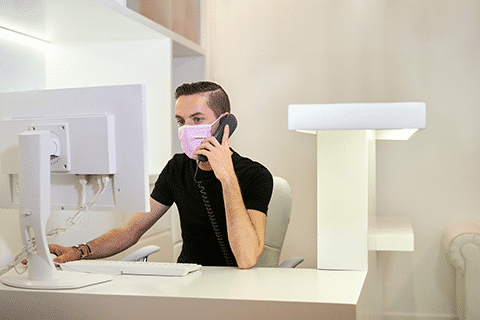According to the Cleveland Clinic, about 36% of people in the United States experience dentophobia, or dental anxiety. Since so many people struggle with this condition, it is important to address and help patients work through it.
Dental anxiety is more than a minor discomfort; it can lead to a range of issues, from missed appointments and neglected oral health to an immobilizing fear each visit. This anxiety can stem from past negative experiences, fear of pain, or even the sounds and smells associated with dental offices. Here are a few tips to help your patients have a positive, stress-free experience.

Communication
Before a patient’s appointment, provide detailed information about what to expect during their visit. This information can include written materials, videos, or even a pre-visit consultation. DentiMax Practice Management Software can directly text patients about their expectations. The better prepared a patient is upfront, the less anxious they will feel in the appointment.
During the exam, invite patients with dental anxiety to share their fears and concerns openly. Understanding where their anxiety comes from allows you to tailor your approach and provide the reassurance they need.

Comfort Measures
Ensuring a welcoming and comfortable space for all patients is vital to keeping fear at bay. Create a calming office with soothing colors, comfortable seating, relaxing music, and a TV. Suggest patients bring a weighted blanket, an audio book, or another distraction of their choosing as well.
The support of a friend or relative may also calm patients’ minds. Even the presence of someone they trust can help them feel safe, comfortable, and relaxed.
When necessary, use effective pain control methods like topical anesthetics, nitrous oxide, or sedation.

Behavioral Techniques to reduce Dental Anxiety
One option to calm patients with dental anxiety is to teach them relaxation techniques to eliminate tension and stress in the body and mind.
Here are a few breathing techniques from Calm clinically proven to calm nerves:
- Focus on making your exhale longer than your inhale
- Practice belly breathing, encouraging full and deep breaths.
- Choose a calming word or phrase and repeat it silently as you breathe in and out.
- Breathe in for four counts, hold for four counts, exhale for four counts, and hold again for four counts.
- Try alternate nostril breathing, or inhaling through one nostril and exhaling through the other.

Continuous Feedback
Ask patients for feedback after the exam is over. What helped reduce their anxiety? How could you make improvements in future visits? Patient input is invaluable in refining your approach to managing dental anxiety. Implement short post-visit surveys focusing on the aspects of the visit that are key to your practice.
Showcase positive feedback from other patients on your website, social media, or in your office. Sharing success stories and positive experiences can reassure future anxious patients that they are in good hands.
Addressing dental anxiety actively can significantly enhance your patients’ experience and improve your reputation. By creating a more welcoming environment, dental practices can help anxious patients feel more at ease, leading to better oral health outcomes.






